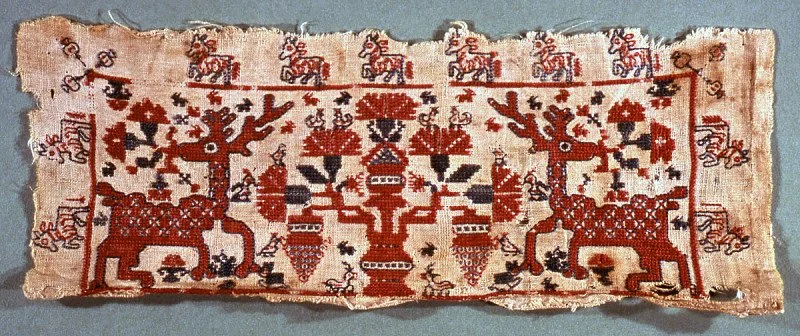Santa Claus (Deconstructed) (with special attention to birch trees, mushrooms and reindeer)
by Susan Goldhor
[This article originally appeared in the December 2017 Newsletter of the Wonalancet Out Door Club. Thank you to Susan Goldhor for permission to reprint.]
My guess is that by the time you read this, it will be more or less Christmas time. So let’s talk about Santa Claus. Surely you’ve wondered about this bizarre figure. We know that Christmas is really a palimpsest over the real celebration which is that of the winter solstice. I’m ignoring Chanukah, whose candle-lighting is another winter solstice solace, but which was originally a very minor holiday that got inflated into a major one so that Jewish kids wouldn’t be too jealous of their Christian neighbors. It doesn’t really work, of course, because seven candles can hardly compete with a whole lit up tree and, no matter how many presents you get, you don’t have the thrill of their arriving via a flying sleigh, pulled through the night sky by reindeer. Somehow, the Christians get it all. Not just the baby in the barn, and the three kings, and the shepherds, and the stars and the angels, but the fir tree, and the reindeer, and the thrilling ride through the night sky, and the delivery of presents to every home via the chimney by a fat man in a red suit with white trim. Wow! Unfair to all other religions! What could possibly match this panoply of thrills? Nothing. That’s what.
Amanita muscaria. Photo by Ruben Hanssen on Unsplash.
No doubt you can tell that I’ve given a great deal of thought to and made a serious study of Christmas. The bottom line is that Christmas, at least as celebrated in America, simply doesn’t make sense. Theoretically, it celebrates the birth of Christ. This gives us the crèche, the angels, the kings, etc. So far, so good. Now we come to the tree, which is invariably a type of evergreen which does not grow in the holy land, and which is often decorated with fake snow. This is usually explained by its being a pagan holdover, especially beloved by Germans and other northern peoples, who were into celebrating the solstice. I can appreciate this, being pretty much pagan myself. Who wouldn’t appreciate the greenery, the lights, and the wonderful smell during the darkest, most indoor time of the year? But Santa? The attempts to explain him are pathetic. A third century Greek or Anatolian saint named Nicholas who is said to have given some gifts to poor people? Sorry. You’ll have to do better than that. It’s true that the name of Santa Claus is derived from Nicholas’ Dutch name (Sinterklaas), and it’s also true that Sinterklaas gives gifts to good children. Let us not forget, however, that he also comes from Spain by boat (switching to horseback when he reaches land), and taking bad children back to Spain with him, which makes sense when you think of the bloody works of the Spanish Inquisition in the Lowlands a few centuries ago and the dread they inspired. But where do we get the red and white costume, the round tummy (unsuited to a serious and probably gaunt saint and martyr), the North Pole locale, the flying reindeer, and the descent down the chimney? Where do we get the total non-Christian weirdness of this character? Where did he originate? And the answer that I find most compelling is that Santa comes from Lapland, with forays into Siberia, and the shamanic use of Amanita muscaria, a widely used hallucinogenic and entheogenic (enabling the consumer to experience god) mushroom.
It’s a safe bet that A. muscaria is the most recognizable mushroom in the fungal pantheon. With its brilliant red cap (apologies for the fact that it’s often orange or yellow in our region), decorated with white warts, it has been called one of the most photogenic mushrooms in the world. And, it is probably the most painted mushroom in the world, appearing in children’s books as different as Alice in Wonderland and Babar, to say nothing of infinite depictions of evil or enchantment or rituals—although not rituals affiliated with religions commonly practiced here. If you were asked to illustrate a fairy tale toadstool, it’s a safe bet that you’d use A. muscaria as your model. Found under birches and evergreens, it has a wide distribution—not only in the circumpolar regions, but much further south. However, given Santa’s North Pole habitat, let us concentrate on the northern habitats and particularly on Lapland and Siberia. Why Lapland along with Siberia? Well, for one thing, this is the home of reindeer herding as opposed to caribou hunting. We should note here that if reindeer have any passion outside of rutting season, it’s for A.m., either the whole thing or those fractions remaining after it has passed through a set of human kidneys. Deer generally love human urine, which is a source of salt, and urine from an A.m. consumer must be absolute manna for reindeer.
Richard Platt writes from England, "Lapp shamans used to eat the mushroom during the midwinter pagan ceremonies of Annual Renewal. The first effect of eating it was a deep coma-like slumber. When the shamans woke the drug stimulated their muscular systems, so that a small effort produced spectacular results—the intoxicated person perhaps making a gigantic leap to clear the smallest obstacle. The effect on animals was generally the same and a mushroom-maddened super-reindeer traditionally guarded each shaman. When missionaries first reached Santa's native Lapland, they found a thriving pagan myth of reindeer flight. Rather than oppose it, they shrewdly assimilated the stories into the folklore of Christmas and Saint Nicholas. . .The colour scheme of his outfit is taken from the unmistakable red and white cap of the fungus. Lapps still scatter the mushroom in the snow to round up reindeer."
St. Nicholas. Robert Walter Weir c. 1837, oil on wood, 29 3/4 x 24 1/2 in., Smithsonian American Art Museum.
But wait! There’s more! The Siberian winter dwelling or yurt, had a smoke hole in the roof, supported by a birch pole. At mid-winter festivals, the shaman would enter the yurt through the smoke hole, perform his ceremonies and then ascend the birch pole and leave. There’s your chimney connection. (Note: Siberians revere the birch tree and a sacred serpent is said to dwell at its roots. This is not a casual connection—the mycorrhizae of A. muscaria also dwell at the birch trees' roots. There has been a fascinating conflation over time of the Tree of Life and the Tree of Knowledge, and at least one authority says that A. muscaria is the apple of that tree. In Kamchatka, one birch in particular, the endemic Betula ermanii, is believed to be the pathway between the world we know, the upper world, and the underworld: a ladder is sometimes made of birch wood to give the shaman a visual means by which to ascend or descend in the shaman’s journey to effect a cure, offer protection from evil spirits, or secure a successful hunt.)
To me, one of the most powerful arguments for a strong linkage between Santa and A. muscaria is the introduction of flying into the legend. Although I draw the line at believing that those who consume A.m. can fly, I do believe that they experience a surge of strength and may feel as if they are flying. Mycologist Gary Lincoff has reported his own experiences swallowing 5 grams of dried A.m. after visiting Siberian Koryak shamans. Some extracts: “A reindeer herd manager we interviewed told us that some of his herders ate the Amanita muscaria when they had to chase after runaway reindeer: the mushroom allowed them to go for long periods of time without stopping to eat or rest… At dinner, I rose to make a toast to our Russian guides. As I stood up, I pushed my chair behind me. It hit the wall and broke in several pieces… On leaving Kamchatka the next day by plane, I tried to attach my seat belt and pulled it out of the seat… Two weeks after returning home I was still feeling the effects of the relatively small amount of the fly-agaric mushroom I had consumed. The primary effect was a sense of power, an upwelling rising from my stomach.”
Amanita muscaria. Photo by Sergei Gussev on Unsplash.
The number of stories about flying, from cultures that use A.m., are impressive. A single example: the Norse deity, Wotan, flies through the sky in a vehicle pulled by animals, and drops of blood from his steeds are said to be the origin of A.m. And so on and so forth. But please don’t try to achieve flight on your own by consuming our local Amanita muscaria variant. All contain a mix of hallucinogenic and toxic elements. Alas, the European mushroom contains more hallucinogens; ours contains more toxins. (Gary Lincoff got his from Siberia.) You won’t die, but you might wish to.
Yes, Virginia, there is a Santa Claus. But he’s a Lapp/Siberian shaman who’s high as a kite. Deal with it.
Banner image: Embroidered linen fragment with a central design of carnations in a vase with reindeer on either side, made in Spain in the 18th century. Cooper Hewitt, Smithsonian Design Museum.

